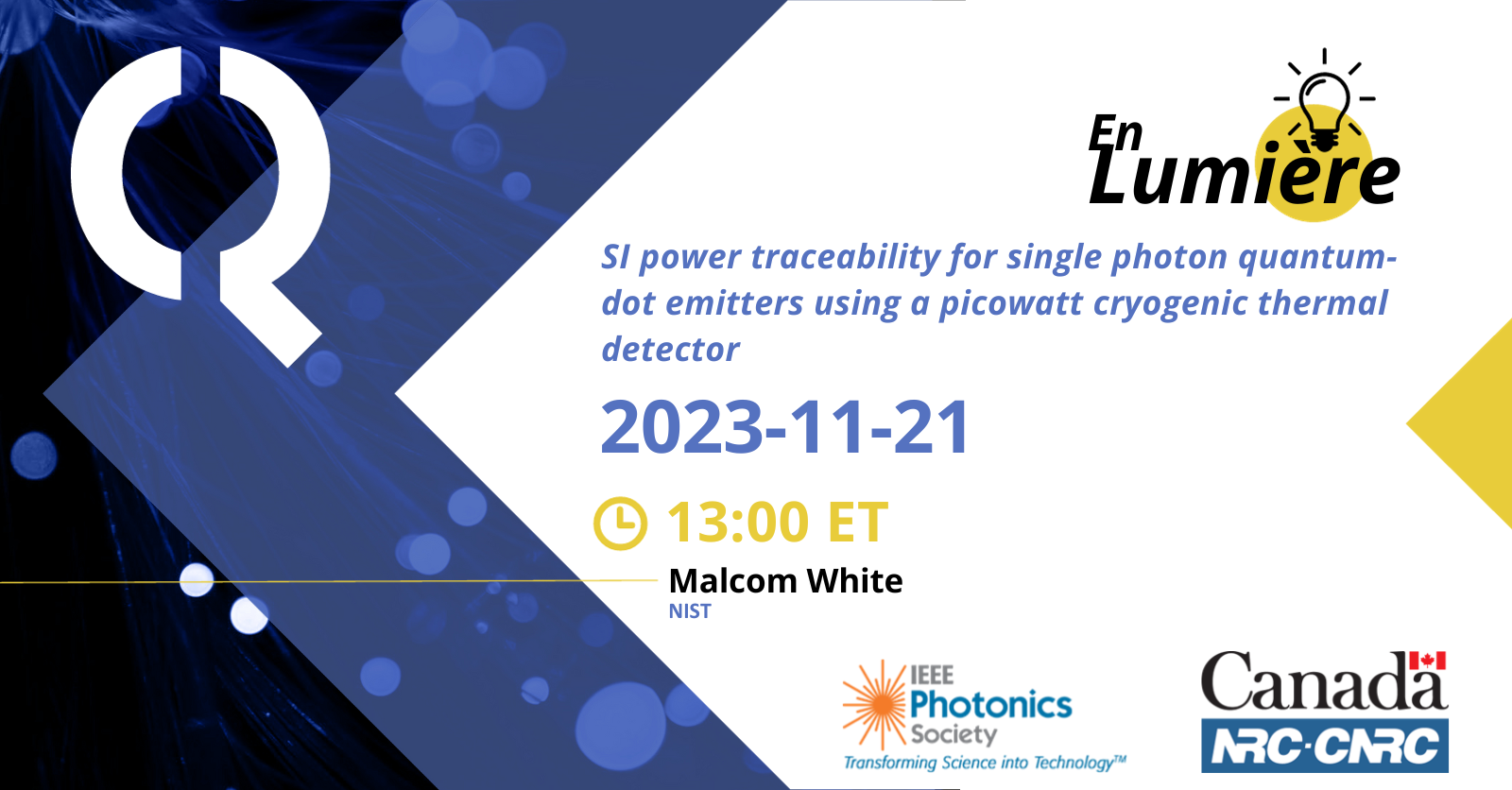SI power traceability for single photon quantum-dot emitters using a picowatt cryogenic thermal detector
The presentation will be in English / La présentation sera en anglais.

The presentation will discuss our latest efforts in developing a picowatt cryogenic thermal detector for use in measuring the emitted optical power from NRC quantum-dot single photon sources, and linking this measurement directly to the SI. I will also discuss the application of frequency-programmable Josephson voltage standards to the direct measurement of the electrical substitution power of the picowatt detector
Date and Time
Location
Hosts
Registration
-
 Add Event to Calendar
Add Event to Calendar
Loading virtual attendance info...
- Contact Event Hosts
-
Boris Lamontagne Boris.Lamontagne[at]nrc-cnrc.gc.ca
- Co-sponsored by National Research Council, Canada. Optonique.
Speakers
Malcolm White of NIST
SI power traceability for single photon quantum-dot emitters using a picowatt cryogenic thermal detector
Abstract: The presentation will discuss our latest efforts in developing a picowatt cryogenic thermal detector for use in measuring the emitted optical power from NRC quantum-dot single photon sources, and linking this measurement directly to the SI. I will also discuss the application of frequency-programmable Josephson voltage standards to the direct measurement of the electrical substitution power of the picowatt detector.
Résumé :
La présentation discutera de nos derniers efforts dans le développement d'un détecteur thermique cryogénique de picowatts pour mesurer la puissance optique émise par les sources de photons uniques et de relier cette mesure directement au SI. Je parlerai également de l'application d'étalons de tension Josephson programmables en fréquence à la mesure directe de la puissance de substitution électrique du détecteur de picowatt.
Biography:
Bio: Malcolm received his MSc degree in solid state physics from Waikato University, New Zealand in 1984. In 1989 he was appointed to the Measurement Standards Laboratory in New Zealand as a research scientist, working with the primary standard radiometer, developing silicon photodiode trap detectors and spectral responsivity systems. In 1996 he moved to the UK and joined the radiometry group of NPL, where he was responsible for maintaining and disseminating the UK’s primary optical radiant power scales. He was the technical work-package leader for the linkage of the SI to the single photon regime for the European Metrology Research Project “towards quantum-based photon standards”
In 2011 he joined the Sources and Detectors group at NIST Boulder where he is developing planar radiometric cryogenic detectors for use as primary standards. His current interests include traceability for few-photon metrology, using quantum standards to potentially redefine the radiant power scale, and applications of radiometry to space-based measurement instrumentation
---------------------------------------------------------------------
Biographie :
Malcolm a obtenu sa maîtrise en physique du solide de l'Université de Waikato, Nouvelle-Zélande en 1984. En 1989, il a été nommé au Laboratoire des normes de mesure en Nouvelle-Zélande en tant que chercheur scientifique, travaillant avec le radiomètre étalon primaire, développant des détecteurs de pièges à photodiodes au silicium et des systèmes de réactivité spectrale. En 1996, il a déménagé au Royaume-Uni et a rejoint le groupe de radiométrie du NPL, où il était responsable de la maintenance et de la diffusion des principales échelles de puissance rayonnante optique du Royaume-Uni. Il a été le responsable du groupe de travail technique pour le lien entre le SI et le régime des photons uniques pour le projet européen de recherche en métrologie « vers des normes de photons basées sur le quantum ».
En 2011, il a rejoint le groupe Sources et détecteurs du NIST Boulder où il développe des détecteurs cryogéniques radiométriques planaires destinés à être utilisés comme étalons primaires. Ses intérêts actuels incluent la traçabilité pour la métrologie à quelques photons, l'utilisation d'étalons quantiques pour potentiellement redéfinir l'échelle de puissance rayonnante, et les applications de la radiométrie aux instruments de mesure spatiaux.
Due to limited spaces onlines, registered IEEE members will get priority to access the webinar.

